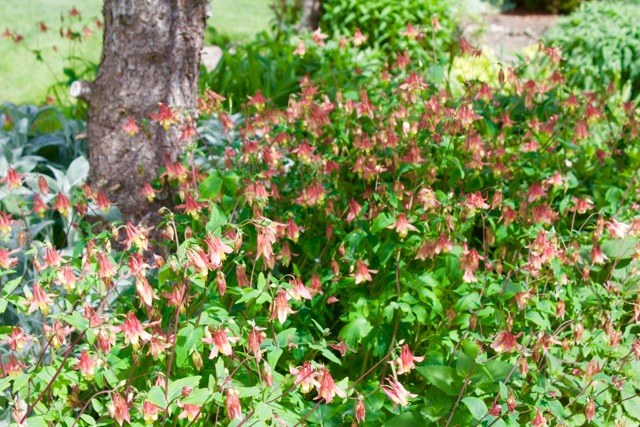Posted: October 26, 2021
If you are interested in adding more native plants to your garden, this is a good place to start.

Eastern Red Columbine (ital)Aquilegia canadensis(end ital)self-seeds to fill in bare spots. Photo by B. Mrgich
If you are a serious gardener, you have most likely read many articles about the beauty and value of native plants. Here is a little beauty you may be interested in adding to your collection if you don't already have it. The plant I am referring to is Eastern Red Columbine Aquilegia canadensis. If you are interested in adding more native plants to your garden, this is a good place to start. Native plants are known for being easy, non-fussy growers while supporting our natural wildlife including bees, birds, and butterflies.
Most of us are familiar with the hybrid Columbine which we see at all the nurseries. It is a beautiful and unique looking flower and comes in many colors. I grew it for many years. The flowers were great, but the leaves always became disfigured by leaf miners (little worms that eat their way through the leaf) making the foliage very unattractive. The natives are more resistant to the leaf miners. In fact, since I grow the natives now, I have never had the problem again.
The native Columbine is a pendant type flower that dangles face down with nectar-bearing "spurs" which stand straight up. It is dainty and pretty plant that grows about 12" - 18" tall.
Columbines bloom in early spring, usually at the beginning of April and continuing through most of June. They are known to reseed readily if you have good, rich soil. I brought one native Columbine home some years ago and planted it where it has since been somewhat crowded out. Two years ago, I was forced to limb up an old Colorado Blue Spruce because the bottom limbs were dying. By the following year, the area was completely filled with the red Columbine.
They not only moved themselves with no help from me, they knew right where to go -- light shade and semi-moist soil. (And it isn't even very close to their old home.) I learned later, that Columbines do not like root competition, so it is not unusual for them to move to a more open space.
After the Columbines bloom, they form seed heads like all other flowers. If you don't want so many volunteers, simply trim off most of the seed heads along with their long stems, and the plant will stay attractive for the rest of the growing season. This plant is actually a perennial that is sometimes short-lived. Let it reseed to a certain extent to ensure your plants will continue.
You may be wondering why I am talking about a spring-blooming plant in the fall. It's because it is easiest and least expensive to grow Eastern Red Columbine from seed, but you need to plant those seeds in the fall because they need stratification (an extended period of cold) in order to germinate.
Just scratch up the soil and remove any sticks or debris, scatter the seeds, cover very lightly with soil, and be sure the area stays damp.
Eastern Red Columbine is your calling card to attract the Ruby-Throated Hummingbirds as they migrate north in the spring. Sometime in April when the hummingbirds begin to arrive, it will be there waiting to supply desperately needed nectar to sustain the exciting little birds. In addition, Columbines are attractive to many early pollinators for their pollen and nectar.
Once those hummers have arrived, keep them there by also providing a steady stream of red or tubular blooms around your garden area. Native honeysuckle is a favorite in my gardens, along with annual red salvia, red Canna lilies, and many other annuals. They don't have to be red flowers. Red is just the color that best attracts them. Once the hummingbirds are in your yard, they will often use other flowers. From my observation, salvias are most successful at attracting them. If you have enough blooms to satisfy them, they will hang around and not require feeders. Feeders can be a lot of trouble with constant cleaning and refilling. I, personally, would rather feed the birds naturally.
Native Columbines are also a host plant for the Columbine Duskywing Skipper. A skipper looks like a tiny butterfly. It is actually somewhere between a butterfly and a moth. It is recognized as an important pollinator. If you see munching evidence on their leaves, you know your Columbines are doing their job.
Barb Mrgich is a Penn State Master Gardener from Adams County. Penn State Cooperative Extension of Adams County is located at 670 Old Harrisburg Road, Suite 204, Gettysburg, phone 334-6271.
Monday videos: Visit us on Facebook at Penn State Master Gardeners in Adams County for our Master Gardeners' Monday Videos. Timely and relevant topics will be discussed on a weekly basis keeping readers up to date on current horticultural issues.

